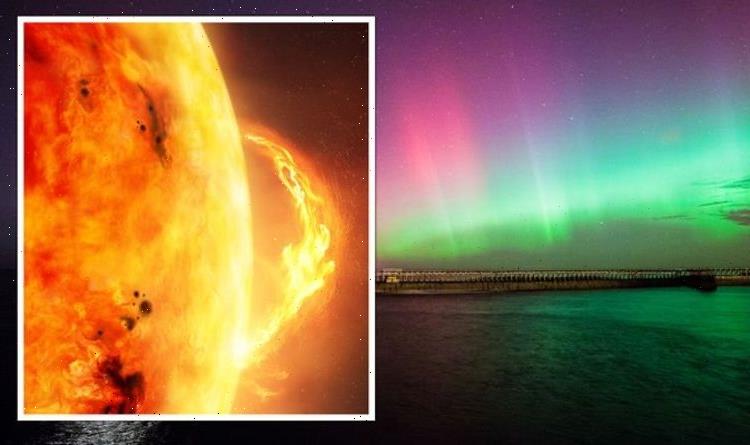Earth’s ‘magnetic song’ captured during solar storm
We use your sign-up to provide content in ways you’ve consented to and to improve our understanding of you. This may include adverts from us and 3rd parties based on our understanding. You can unsubscribe at any time. More info
Aurora Alerts UK issued a “red alert” at 7:23am, stating that the Northern lights may be visible in the northern parts of Britain and could continue tonight. It comes after a solar flare hit Earth’s magnetic field at around 3.30am this morning. It sparked a G2-class geomagnetic storm that is now underway and is expected to last until 4pm.
The coronal mass ejection (CME) from the Sun has turned the sky into a beautiful colour.
Eyes were cast upwards to glowing skies above parts of England’s north, Scotland and Northern Ireland.
Twitter user @hazelmpinner, from Kirkwall, said: “Not the best photo but taken using my phone and my hands that aren’t the steadiest with it being cold.
“But there was definite aurora glow, not bad for 10 minute walk from the house.”

@Calder1Julie, from Orkney, added: Been aurora watching for a few hours now and all we can see is a green flow at the other side of the clouds.”
But others were not so lucky.
Twitter user @Just_a_coolbean added: “Stayed up most of the night awaiting the Aurora Borealis, but the clouds are so thick in the north of UK & all seems very unlikely.”
That is unfortunately due to the weather.
The Met Office said that the Aurora was “likely to occur over much of Scotland and perhaps extend into northern England and Northern Ireland tonight.
A spokesman said: “For many in these areas it will be too cloudy but there are some spots in with a chance.”
The agency added: “Aurora is possible through 11th and 12th across much of Scotland, although cloud amounts are increasing, meaning sightings are unlikely for most.”
Astronomer Tom Kerss added: “Unfortunately I think cloud cover is going to be a bit of an issue for Scotland but it doesn’t mean that you shouldn’t have a go if you have any clear patches at all.”
That has not stopped the rest of the world, though.
Space weather physicist Dr Tamitha Skov tweeted at 5am: “Finally! Storm time is here! The tell-tale gorgeous reddish hues are now burning brightly over the skies in northern Iowa, USA, during this ongoing solar storm.”
The NOAA said that the aurora may be seen as low as New York to Wisconsin to Washington state.
Jonina Oskarsdottir, who spotted spectacular views from Iceland, said: “I had a wonderful time looking at the pinkest Northern Lights I have seen in several years as they danced in the sky over Fáskrúðsfjörður.”
Most auroras are green, which is the colour of atoms struck by energetic particles from space 100km to 30km above Earth’s surface.
Pink can appear when energetic particles descend lower than usual, striking molecules at the 100km level and below.
This CME impact apparently created this type of extra-penetrating “rain”.
Currently, the storm is travelling and 462.3km/sec which is a normal speed for solar wind.
While this storm is G2 rated, solar storms are ranked from G1 to G5, and stronger storms having the potential to cause complete radio blackouts.
But even a G2 storm has the potential to cause major disruption if it collides with a satellite.
The Space Watch Weather Prediction Center (SWWPC) warned that the storm is classed as moderate, but even that can cause power grid fluctuations and high-latitude power systems may experience voltage alarms as the storm continues to build.
This could cause satellite orientation irregularities which could be devastating for billions on earth as fears of internet outages and disruption to global communication still look like a possibility as the solar storm’s increased drag on low Earth-orbit satellites has not been ruled out by SWWPC.
Source: Read Full Article
